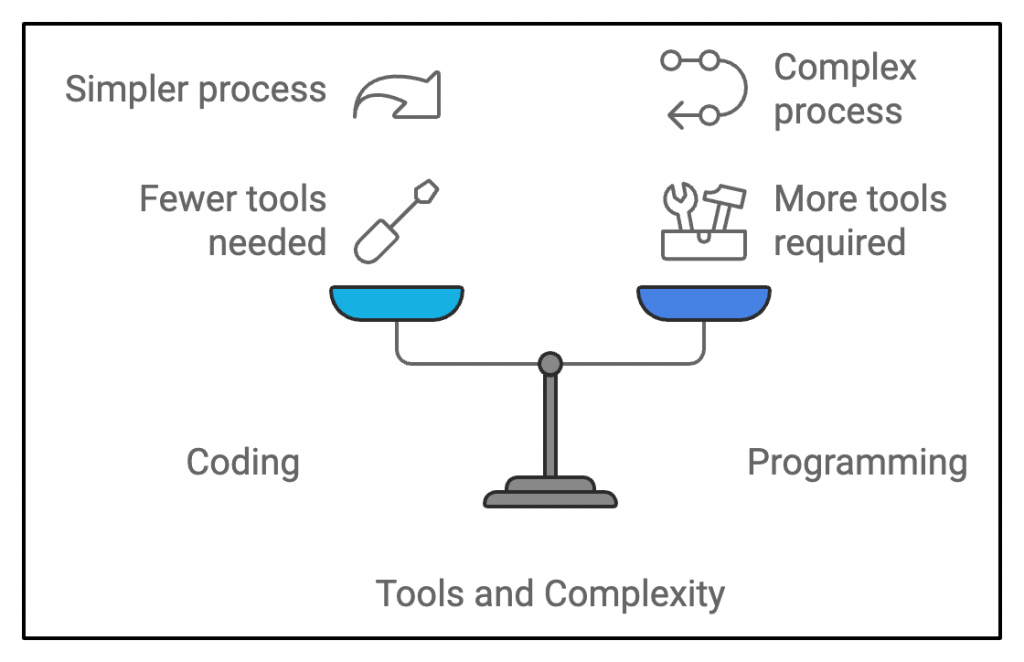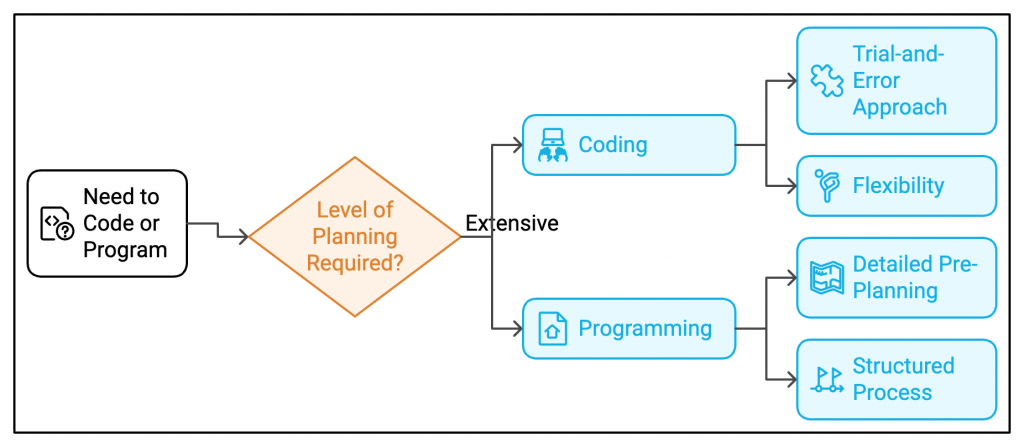Coding vs Programming: 5 Most Important Differences
We live in a world dramatically impacted by technology. The average person will need to be tech-savvy to thrive in the business world of the future. Many jobs are now based on computer skills, two of them are programming and coding.
Coding is something that is now being taught in schools around the world. It has become clear that it is essential knowledge, and the current generation is starting younger than any of the previous generations. Coding allows humans to communicate with computers by using specific languages. By writing lines of code, we give the computer instructions it can execute, such as performing calculations, running programs, or displaying information. Coding is foundational to most digital technologies, powering everything from websites to applications and operating systems.
But what exactly is coding? And what is programming? These are two commonly discussed skills, but people outside of the computer science industries often consider them the same thing. Coding in software refers to the process of writing instructions that a computer follows to perform a task. Whether you’re creating a simple script or a complex application, coding involves translating human ideas into commands that computers can understand. Languages like Python, JavaScript, and C++ are used to create functioning software solutions.
The difference between coding and programming lies in their scope. Coding focuses on writing specific instructions, whereas programming encompasses the entire development process, including planning, debugging, and testing. Although related, they are not the same. Knowing what differentiates coding and programming will give you a heightened understanding of what both truly are.
Let’s dive into the details of what separates programming from coding to add insight into exactly what both are. Ready? Let’s get into it.
Coding definition
Coding is the act of writing instructions in a language that computers can understand, allowing them to perform specific tasks or solve problems.
Programming definition
Programming is the broader process of designing, writing, testing, and maintaining software systems, where coding is one part of the entire development cycle.
Programming Requires More Knowledge
Programming and coding are not the same. Coding is a component of programming, where you write specific instructions. Programming, however, encompasses much more, including planning, testing, debugging, and maintaining software projects. While a coder focuses on writing code, a programmer must think holistically, designing systems and ensuring they function correctly.

Both coding and programming require a solid understanding of advanced concepts, but programming often demands deeper knowledge, particularly in areas like system architecture and design. Both are inaccessible to the typical person without previous training. However, between the two, programming will require a significant amount more knowledge.
This is largely because coding is a component of programming. Coding is the process of speaking to a computer through a “language” it understands. There are numerous different languages that computers understand, ranging from HTML and CSS to Javascript.
Coding inputs instructions for machines to follow. It is a valuable skill that is a significant part of many different businesses and technologies. However, with programming, you need to know how to code and more.
This is because programming uses coding and other skills to take things a step further. Programming requires testing, maintenance, design, and various other skills. If you are creating a new software technology, you will need to know how to code, but you’re also going to need to know a lot more.
Programming is a significantly taller task because coding is only one part of it. While it is a critical part of programming in many cases, the programmer will also need more knowledge than purely coding.
Programming Requires More Tools
Because programming is a more complicated process, how it is done differs from coding. For starters, the methods used differ, but we’ll get to that later. The important difference we’re discussing right now is the difference between the tools used for each.
Several different tools can be used for coding. Popular coding tools include things like Sublime Text and WordPad. But because coding is only one part of programming, it is natural that a programmer will need more tools.

Programmers have a variety of different tools that they may find themselves needing. Modeling programs, testing frameworks, and much more may be required. This is because a programmer will have to go more in-depth with their research. In programming, coding refers to the act of translating a plan or an algorithm into machine-readable instructions. Coders take the concepts created by programmers and transform them into a language that computers can execute. Coding is thus a critical part of the software development process, ensuring that logical ideas become functioning digital solutions.
Both coding and programming are complicated processes that require expert insights. Coding can be done using far fewer tools, though, and programming will require various software solutions.
Coding in Software Engineering
Coding in software engineering is an essential part of building reliable and scalable systems. Software engineers use coding not just to write programs but to solve large-scale technical challenges. Coding at this level involves understanding algorithms, system design, and long-term maintenance. It’s about creating solutions that are optimized for performance and future-proofed for scalability. Unlike basic coding, which focuses on specific tasks, software engineering requires a deep understanding of how various components work together within a system to ensure it runs smoothly over time.
Different Approaches
oding often looks like a series of commands written in a programming language. These commands can include words, numbers, and symbols that direct the computer to perform specific tasks. For example, a simple Python code might look like this:
print("Hello, World!")This line of code instructs the computer to display “Hello, World!” on the screen, giving a small glimpse into how coding translates human commands into machine actions.
The differences in approach for both programming and coding extend beyond the use of different tools. How the developer goes at each situation is going to be different. This is because programming and coding have significant differences between the level of planning and foresight required.
You must have extensive past knowledge for coding, but it doesn’t require the same degree of planning as programming. Coding is based on a trial-and-error approach. You can type in a few lines of code, see if they are working, and if not, consider what you need to change.

Of course, you still need to have an idea of what you’re trying to accomplish, but part of the beauty of coding is that you can learn and adjust on the fly. With programming, you may not be afforded that same luxury.
Programming is going to require a drastic amount of pre-planning. Going deep into programming without a clear idea of what you need to do will fail because there are more moving parts. Everything has to be connected and thought of beforehand, or the programming won’t work.
Both coding and programming require forethought and attention to detail. However, with coding, there is room to take a trial-and-error approach. With programming, a trial-and-error approach will typically end in error.
Timeline is Different
Understanding your timeline is important when you tackle a task, particularly a business-oriented one. Most of the time, a clear timeline is significant to the interests of both clients and your business. There is a clear difference between the timeline with coding and programming.
The timeline for coding is dependent on the magnitude of the task being taken on. There are coding tasks that will take extended periods because there are a lot of errors to fix, or you are starting something from scratch. However, there are answers to many different coding questions on the internet, and some coding can be copied and pasted from past work or online resources.
The difference between coding and programming lies in their scope. Coding involves translating ideas into instructions for computers, usually focusing on individual tasks. Programming, however, involves a broader process, including designing, testing, debugging, and maintaining the software. While coding focuses on writing the actual instructions, programming requires problem-solving skills and strategic thinking.
With programming, it is typically a much longer time investment. Programming is more about creating something new, and that will take a significant amount more time. The timeline for programming can range from day to weeks to months to years, depending on what is being developed.
While coding projects can take a drastic amount of time, it is likely coding for programming projects takes the longest. Programming is a lot longer-term of a project than coding because of the additional tools, knowledge, and planning that goes into it.
Each Create Something Different
At the end of the day, the outcome is everything. The entire coding and programming process is intended to deliver a desired outcome. However, the desired outcome of coding and programming can be entirely different.
The desired outcome of coding is to create a solution to a problem or need by writing in the language that computers use. It is an input-output process used for smaller projects or as a component of bigger projects. Coding translates human desires into sequences that computers can then use to make desired changes.

Programming is more geared towards building something of a larger scale. Programmers will develop a software concept, create instructions for computers to follow that concept with code, and then test and optimize what they’ve created. Eventually, what they’ve developed can be anything from a new application to a new computer program.
Computer programming involves much more than just coding. While coding translates ideas into commands, programming includes stages such as designing, testing, and deploying software solutions. Coding plays a key role in programming, but programming covers the entire lifecycle of creating and maintaining digital systems.
The goals of programming and coding aren’t necessarily mutually exclusive. The parameters for coding are just smaller, as it can be a component of programming. To put it simply, programming is focused on a larger-scale solution, while coding can either be a part of that solution or something smaller-scale.
What’s the difference
| Aspect | Coding | Programming |
|---|---|---|
| Scope | Specific tasks or instructions | Broader process involving multiple tasks |
| Focus | Writing code in a language computers understand | Designing, testing, debugging, and maintaining systems |
| Tools Required | Basic tools like text editors (e.g., Sublime Text, Notepad++) | Advanced tools (e.g., IDEs, testing frameworks, modeling tools) |
| Knowledge Required | Understanding of one or more programming languages | Deeper understanding of system design, algorithms, and architecture |
| Approach | Trial and error | Requires extensive pre-planning |
| Outcome | Produces specific instructions or small components | Develops complete software systems or applications |
| Timeline | Shorter, depending on the complexity of the task | Longer, especially for large-scale projects |
| Flexibility | More flexibility, can make changes on the go | Less flexibility, requires thorough planning from the start |
Conclusion
Coding and programming are software development tactics requiring advanced knowledge and experience. Coding and programming are modern skillsets with extremely high values, and familiarizing yourself with their intricacies is a smart career move.
Knowing the differences between coding and programming will provide you with a better understanding of the specifics of each. The primary differences to note are that coding can be a programming component, requires fewer tools, and a different approach. The timeline for each is different, as are the desired outcomes.
If you are interested in coding and programming, we’d love to hear from you. Comment below some of the critical differences you’ve noticed between the two, and follow us on social media for more insights.
FAQ
What’s the difference between coding and programming?
Coding involves writing instructions for computers, while programming includes coding along with other processes like testing and system design.
What does coding do?
Coding translates human instructions into commands that computers can execute, making it essential for software development.
Are programming and coding the same?
No, coding is part of programming, but programming involves more complex processes like system design and testing.
What does coding look like?
Coding consists of writing commands in a programming language, which computers follow to perform tasks.



